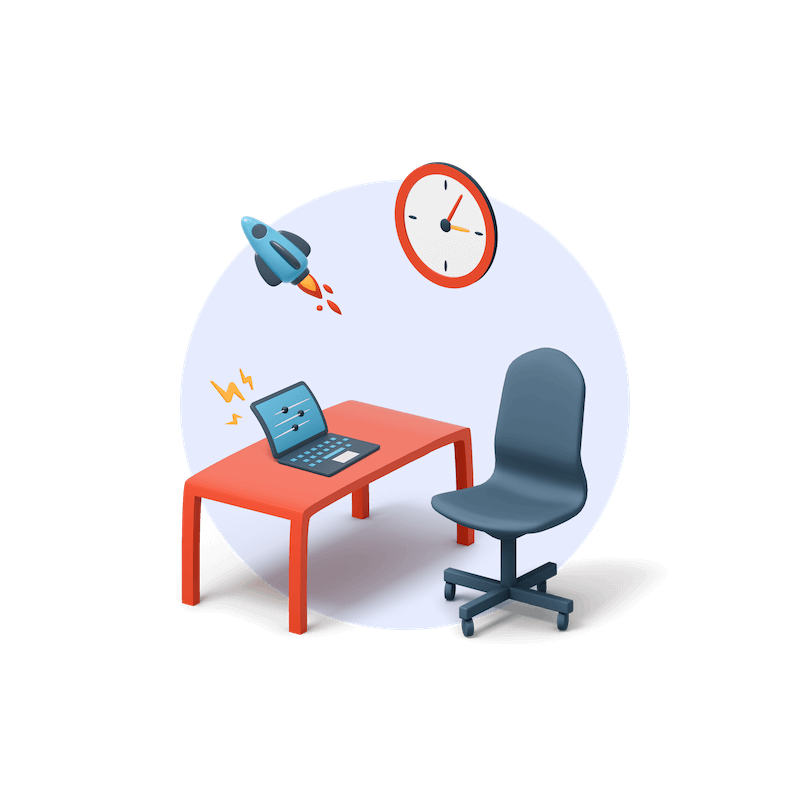In recent years efficient time management skills have become significantly important. We live fast, work hard, and often can struggle with expectations. Using time management techniques devising and working on your to-do list can help you coordinate your tasks better and maximize your productivity. All these while maintaining a good work-life balance.
If you want to get more tasks done in your day, you’ll find this article super resourceful. We’re going to discuss some of the most popular time management strategies to try out in 2025.
First, let’s look at what the term time management technique means and how implementing these techniques can help you be more productive.
Table of Contents
What Are Time Management Techniques?
Time Management Techniques are practices that aim to improve how you spend your time in the workplace and in your personal life. Some techniques, like The Eisenhower Matrix, were developed decades ago (during World War II) and are still relevant.
Others, like Flowtime Technique from 2015, are more recent and have a more modern approach to fit our busy schedules.
Overall, time management techniques aim to:
Increase your productivity
Reduce stress
Gain better control of your to-do list
Meet deadlines
Regardless of your motivation, adding the correct time management technique into your routine will bring positive outcomes. You’ll improve how you handle the important tasks in your work, study, and personal life.
How Do Time Management Techniques Boost Productivity?
The prime goal of time management techniques is to consciously control how you allocate time for important tasks. Soon after you start using them, you’ll see your time management skills improve. As you practice the methods every day, they will soon become your habit.
You’ll learn how to make smart choices. People often cannot decide what to do first or how long to work on a single task before moving on to the next one. This is where mastering the right time management technique can make a difference. It’ll help you learn how to manage your to-do list and time and categorize all your tasks.
So you’ll never worry about what you’re supposed to do or deal with the stress of realizing an important task is overdue at the very last moment because it flew under your radar.
Popular Time Management Techniques
Now, let’s dig into the 17 most popular time management techniques to try in 2025.
1. Pomodoro
The Pomodoro technique was developed by Francesco Cirillo back in the 80s. Cirillo was an Italian student who struggled to complete his assignments due to poor time management and lack of productivity. So he came up with the time management technique so that he could focus on one single task at a time.
He set a popular Pomodoro (Italian for tomato) shaped kitchen timer to reserve blocks of time in which he would focus on single tasks.
In Cirillo’s method, each Pomodoro lasts 25 minutes. After your first Pomodoro ends, you take a five-minute break. Then, when you complete your fourth Pomodoro, you take a longer break. This gives your brain time to relax and regenerate before your next set of Pomodoros.
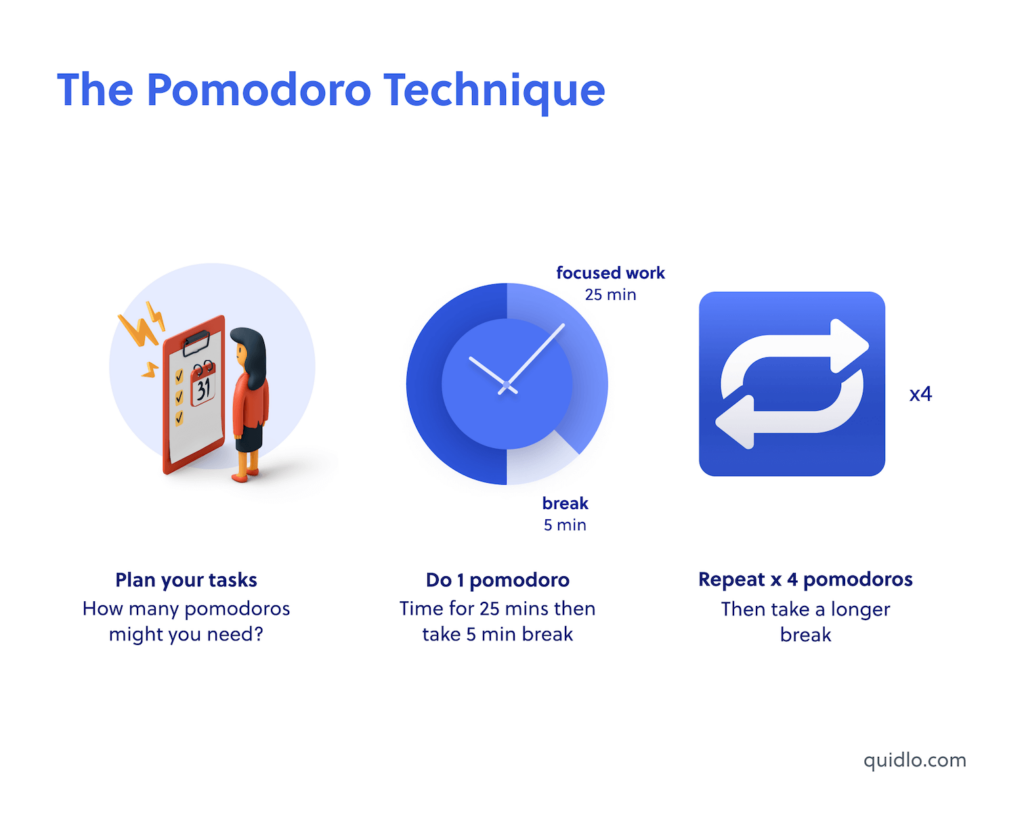
Any complex tasks that require a lot of Pomodoros, should be split into smaller jobs. Minor assignments that don’t need a full Pomodoro should be grouped.
This time management strategy helps you know exactly how long you spend on each task and where your time goes. It’s also pretty straightforward. You define your to-do list, use an online Pomodoro tracker, and work toward achieving your objectives until they are completed.
The downside of the Pomodoro technique is that you start your session all over again when interruptions occur. Also, even if you’re doing remarkably well, you’ll need to cut your momentum short after 25 minutes to take a break.
2. Getting Things Done (GTD)
The Getting Things Done time management technique was invented by David Allen, the author of a very popular and influential business book of its times, “Getting Things Done: The Art of Stress-Free Productivity.” The book was released in 2001. It describes time management systems that prove to work.
The GTD technique is a five-step method to brainstorm your tasks and put them into a straightforward to-do list. The steps include:
Capturing – where you note down any task that comes into your mind
Clarifying – decide what to do with your tasks; you can either do them, delegate, or lay off
Organizing – categorize your tasks, and attach labels, so they are easy to manage
Reflecting – review your tasks regularly to ensure you’re on track
Engaging – take actionable steps to start working on your tasks
The GTD method will help you keep all your projects in perspective. However, it requires you to clear your head once you put every assignment in front of you.
The time management method involves effective planning and setting priorities on your job list. Online task management tools and to-do lists can help you make significant progress with the GTD method.
However, this technique also has some disadvantages. For instance, you have to use your willpower to make progress with the tasks. Some people may struggle to keep going. There are no guidelines on dealing with distractions, and if your to-do list is loaded with assignments, it may not work effectively.
3. Eat The Frog
Eat The Frog time management method focuses on prioritizing the jobs on your to-do list. It was developed and described by Brian Tracy in his 2001 book “Eat that Frog! 21 Great Ways to Stop Procrastinating and Get More Done in Less Time.”
The technique is based on famous words by Mark Twain:
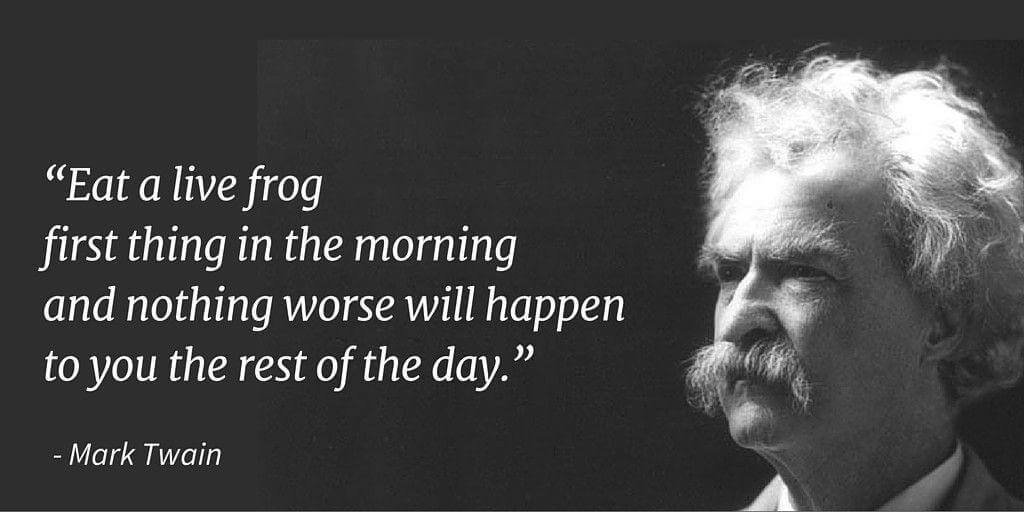
According to Tracy, if you start your day doing your most important and “worst” task (eat your frog), everything else will be easy to get done afterward. This may be a task you tend to put off because it’s difficult, intimidating, or boring.
According to this technique, you should label your tasks based on their priority:
Task A – the most important task of all your jobs (your frog) that you will tackle first.
Task B – the second most important task that you should work on after completing task A. Task B is less important than A but also necessary.
Task C – other tasks that you could do, but they aren’t essential, and you wouldn’t suffer consequences if you didn’t do them.
Task D – jobs that you can delegate to someone else.
Task E – tasks that aren’t needed at all. Therefore you can cross them out from your to-do list.
Implementing the Eat That Frog method will make prioritizing tasks and time management easier. Since you will deal with the hardest task first, you’ll have the rest of the day for the more pleasant jobs. This will motivate and energize you to complete all tasks as scheduled.
This technique may not work if your job includes urgent tasks that appear in the middle of the day. Also, some people may struggle to let go of some of the tasks they should delegate and eliminate.
4. Rapid Planning Method (RPM)
The Rapid Planning Method is among the other time management techniques that are considered a system of thinking. It was invented by Tony Robbins, an American motivational speaker and business strategist.
The RPM method requires deciding on what you’re going to focus on and making it happen. Apart from Rapid Planning Method, the RPM stands also for the Results-oriented Purpose-driven Massive action plan.
Your goal should have the following characteristics specified:
Results: What results do you want to accomplish?
Purpose: Why do you want to achieve these results?
Massive Action plan: What do you need to do to achieve desired results?
According to Robbins, the key to completing your goal successfully is training your brain to envision what you want and make it real.
The technique works well for setting long-term goals. It’s flexible as you set your RPM blocks to work on the assignments to achieve desired outcomes.
Although the RPM is another one from the pool of good time management techniques, it doesn’t involve prioritizing. So, when using this method, you won’t differentiate your important tasks from your less important tasks.
5. Pareto Analysis (80/20 Rule)
The Pareto Analysis, invented by an Italian economist Vilfredo Pareto, is also known as the 80/20 rule. This decision-making rule assumes that 20% of your input is responsible for 80% of the result. The 80/20 rule fits into many different areas of life, including time management.
It’s important to identify your most important tasks and work on them until completion. To make it work, you should list the problems you want to solve. Next, you should identify the root cause of each problem. Each issue gets a score where your most important thing gets the highest score.
You can group tasks and problems if they are similar and add the score for every group. The group with the highest score is the one that you should work on first.
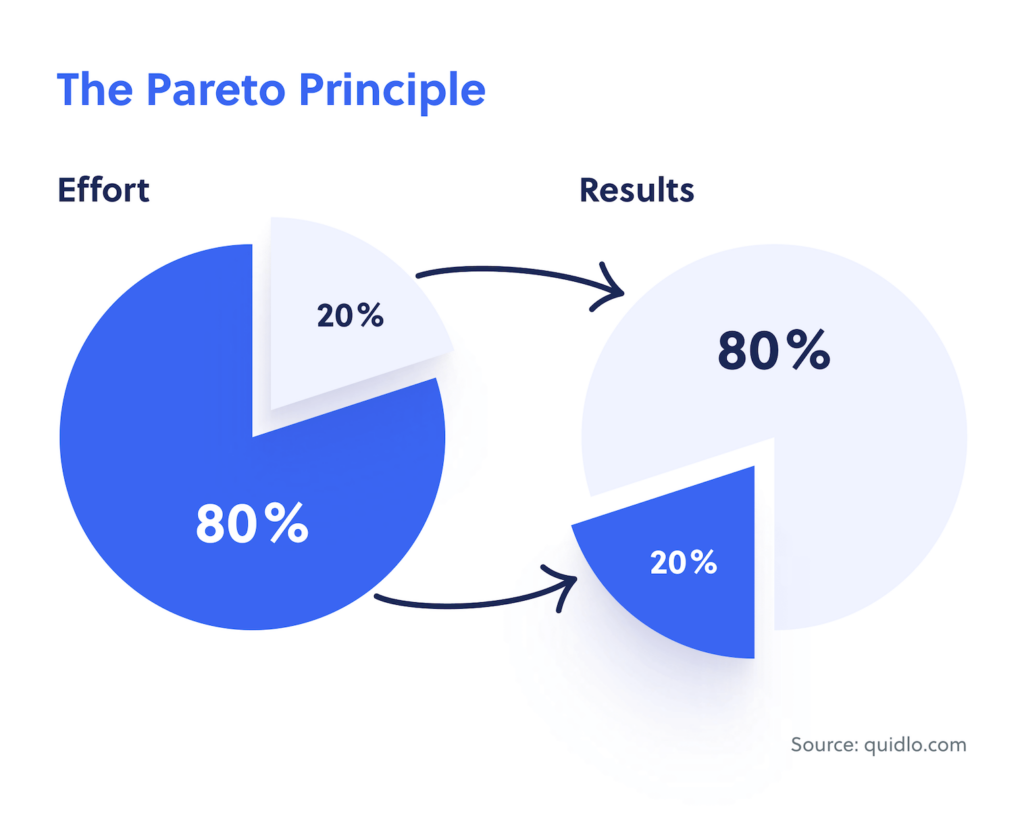
The advantages of this method include improving your time management and prioritizing skills. In addition, you learn to focus on a single task, monotasking, instead of multitasking.
On the downside, your scoring system may be off. If you assign high scores by mistake, you may end up neglecting some important tasks.
6. Timeboxing
The Timeboxing technique was first explained in a “Rapid Application Development” book by James Martin. It works well in an office environment while working on multiple projects at once.
Timeboxing involves allocating periods of time, called timeboxes, to spend on a particular activity. Similar to monotasking. And, when the time runs out, you stop working on it.
Using this method helps to eliminate missed deadlines and skip breaks. Timeboxing excludes multitasking. You’ll focus on one task at a time. It’s a more strict version of the Time Blocking technique described below.
The downside is you can get your time scheduling off for some of the projects. That would mean the time limits you allocate may be too short or too long for some tasks.
7. Time Blocking
With the Time Blocking time management technique, you block out time for a specific task. While timeboxing limits the amount of time you spend on an activity, with the time blocking method, you only reserve a spot in your day for that task. The time you spend on it is up to you. In practice, you divide your day into chunks of time.
Elon Musk sees the time block method as the right time management technique as he popularized it in his working pattern.
This time management technique gives you a comprehensive way to track your workload and time spent on tasks. It’s single-task oriented and helps to avoid distractions and missed deadlines.
On the other hand, it doesn’t tolerate unexpected interruptions, and, like in timeboxing, your time calculations may be off for some tasks, especially at first.
You may also find planning every time block in your calendar time-consuming. However, with practice, it can prove to be a very effective time management strategy.
8. The Eisenhower Matrix
The Eisenhower Matrix time management technique was created during World War II by former American President Dwight Eisenhower.
This straightforward time management method focuses on prioritizing tasks. You label each task as either important or not important and either urgent or not urgent.
The time management matrix, as seen below, can help you to prioritize, delegate, or remove a task from your to-do list based on importance and urgency.
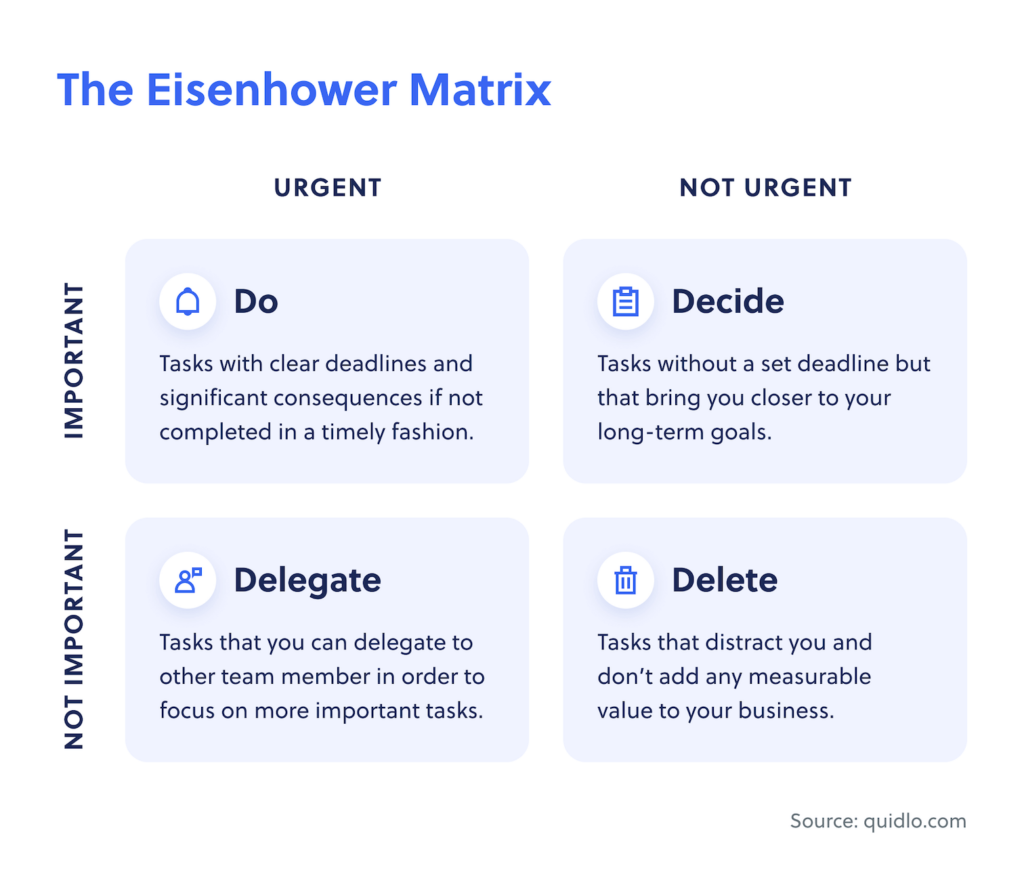
The four quadrants you create help you label your tasks as follows:
Do Now – do your urgent and important tasks first
Schedule – schedule your not urgent but still important task for doing later
Delegate – try to delegate any urgent tasks that aren’t important
Delete – don’t do any tasks that are neither important nor urgent
The Eisenhower Matrix time management technique helps to prioritize tasks effectively and eliminate bad habits.
But, some people may struggle to determine the importance and urgency levels of tasks. You may find it hard to delegate urgent tasks, which are not necessarily important, to others.
9. Flowtime Technique
The Flowtime Technique is a variation of the Pomodoro method that aims to offer more flexibility. It was developed by Dionatan Moura, a software engineer, back in 2015.
In the Flowtime time management strategy, you set a timer, save time for a specific period, and use it as an experimental timeframe for your assignment. This could be anything between 10 to 90 minutes.
After the time runs out and you feel that you cannot focus anymore on the task, you take a break. However, If you think you can stay focused for a bit longer, you’re allowed to continue working.
With this technique, the next time you approach a similar task, you’ll know whether your initial choice for the time allocation was right or not. You can then adjust it accordingly.
This method is more relaxed in terms of time allocations for work sessions and breaks. It’s important to keep a record of your start, break, and end times. If you do, you’ll learn how much work time your tasks take and whether you were interrupted or not. If you use a time tracker app, you’ll soon learn when you’re most productive and can focus for the longest.
On the downside, this method’s flexibility and general laxity of rules may come with the risk of forgetting about breaks and burnout.
10. POSEC Method
The POSEC method was created by the author of “The Posec Method of Time Management” book, Steven Lam. It was inspired by Abraham Maslow’s theory of the hierarchy of needs.
POSEC stands for Prioritize by Organizing, Streamlining, Economizing, and Contributing. Working with the hierarchy can help you improve your time and work management skills in the long run.
According to Lam, everyone has needs that must be met so that they can move up a ladder of success and efficiency. Here are the five needs you have to address in the POSEC method:
Prioritize tasks, life goals, and things that you consider important
Organize your tasks and goals; make a plan on how to work towards achieving them
Streamline routine tasks and chores (small things you don’t want to but must do)
Economize on your to-do list what’s enjoyable and what’s not but still has to be done
Contribute to the community, try to make a positive difference around you
As you can see, this method, unlike other time management strategies, helps to make time not only for your work-related tasks but also for pleasure. You’ll learn to prioritize, manage time and keep a healthy work-life balance.
Despite all the advantages, it isn’t the most practical method for organizing your daily tasks.
11. Pickle Jar Theory
Another practical time management strategy is called The Pickle Jar Theory. This method aims to differentiate your useful tasks from unuseful ones.
Visualize a glass jar as your work time. You fill your jar with rocks, pebbles, and sand, which are your activities. Putting rocks in symbolizes important tasks. Pebbles stand for your urgent jobs, while sand symbolizes distractions. The sand should be laid at the bottom, while the rocks should be at the top.
Here’s a simple illustration of the Pickle Jar theory’s principles:
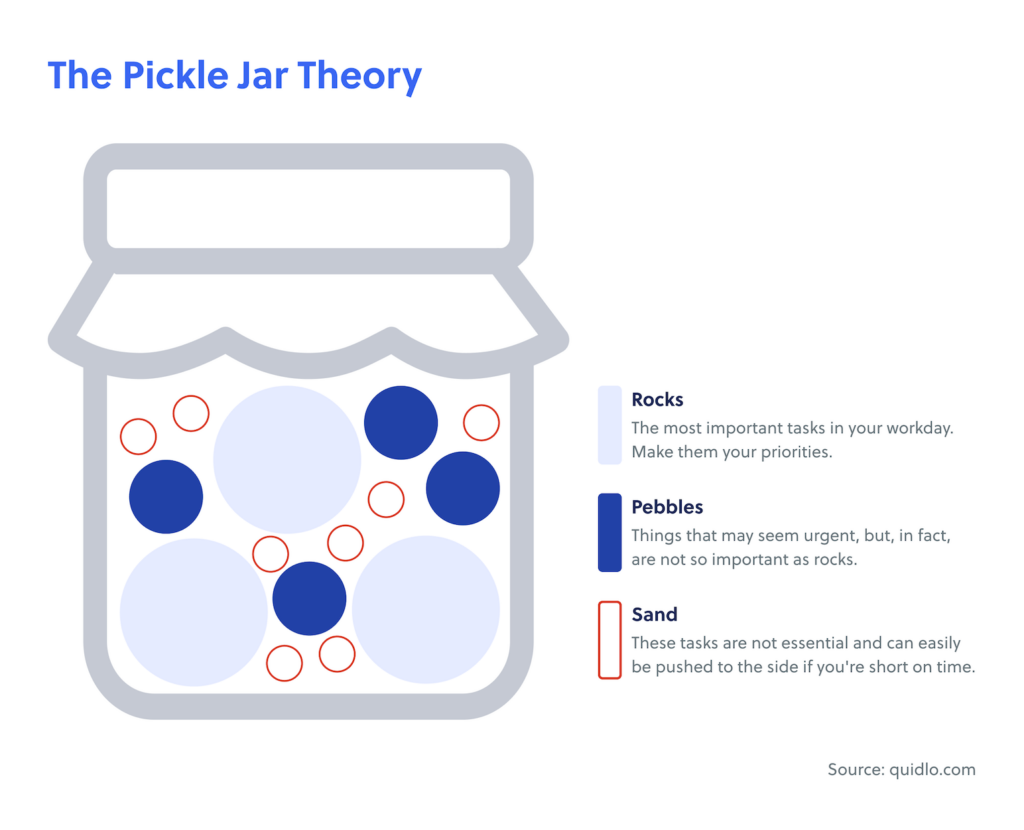
As you visualize your jar with different size objects, you learn to prioritize your tasks clearly. You can plan your jar (time) with assignments according to the level of urgency. Ultimately, there’s only so much you can fit into your jar.
This technique improves your time management skills, as you have to organize your day. However, be aware that if you focus too much on your urgent tasks, you risk missing out on completing your essential tasks.
12. SMART Goals
Creating SMART goals is a technique that helps you create better goals to support your time management efforts. Therefore, it’s not really a technique for managing your time. Rather, it’s a technique to help you create goals that can easily be accomplished with whichever time management technique you pick.
SMART stands for Specific, Measurable, Attainable, Relevant, and Time-Bound. The technique was introduced by George T. Doran in his 1981 paper titled “There’s a S.M.A.R.T. Way to Write Management’s Goals and Objectives.”
The idea is to set your goals within the following criteria:
Specific – make clearly defined goals so you know exactly what you need to do and achieve
Measurable – monitor and assess the progress of your goals; use metrics, figures, or smaller tasks that can help you see the advancement.
Achievable – set realistic goals that can be met with available resources.
Relevant – write goals that align with your long-term plans; you must know why you want to achieve something.
Time-Bound – your goal needs a defined deadline so it’s easier to achieve and measure
The SMART goals technique works great for people who have larger goals that they want to achieve. It makes visualizing success easier and motivates you to move forward and work towards it. Using SMART goals templates can help to create a system that helps you track your goals.
On the other hand, too many ambitious goals can lead to problems such as neglecting your small tasks, struggling with the pressure, or getting addicted to success.
13. Deep Work
The Deep Work method was developed by Cal Newport, the author of “Deep Work: Rules for Focused Success in a Distracted World.” This is another effective time management technique based on prioritization, where you must distinguish between deep and shallow work.
According to Newport, you should focus exclusively on the important task and, at the same time, avoid distractions. Phone calls, social media, and people popping in are the most common distractions at work. Also, the time you schedule for your deep work should be when you have high energy levels.
During your shallow work time, you should do all the small tasks that don’t require your sharp focus—for example, any routine tasks like checking your inbox.
Implementing this method can improve your time management skills and ability to block distractions. You’ll learn to complete challenging assignments and solve complex problems.
One disadvantage of the Deep Work method is that there’s a risk that you may skip breaks. Also, in office environments, it’s hard to avoid distractions from your colleagues.
14. Kanban
Kanban is a visual time management technique adopted in the 1960s by Taiichi Ono, an industrial engineer for Toyota Automotive. The idea was to increase the company’s productivity and effectiveness.
Kanban is a Japanese word for a billboard or signboard. The Kanban board helps you to track progress on your goals by visualizing your tasks. It’s easy to follow the progress of your project tasks as you see them moving across differently labeled columns.
If you’re using a big dry‑wipe whiteboard, draw several columns to visualize the stages of each specific task. Your columns can be labeled To Do, In Progress, and Done.
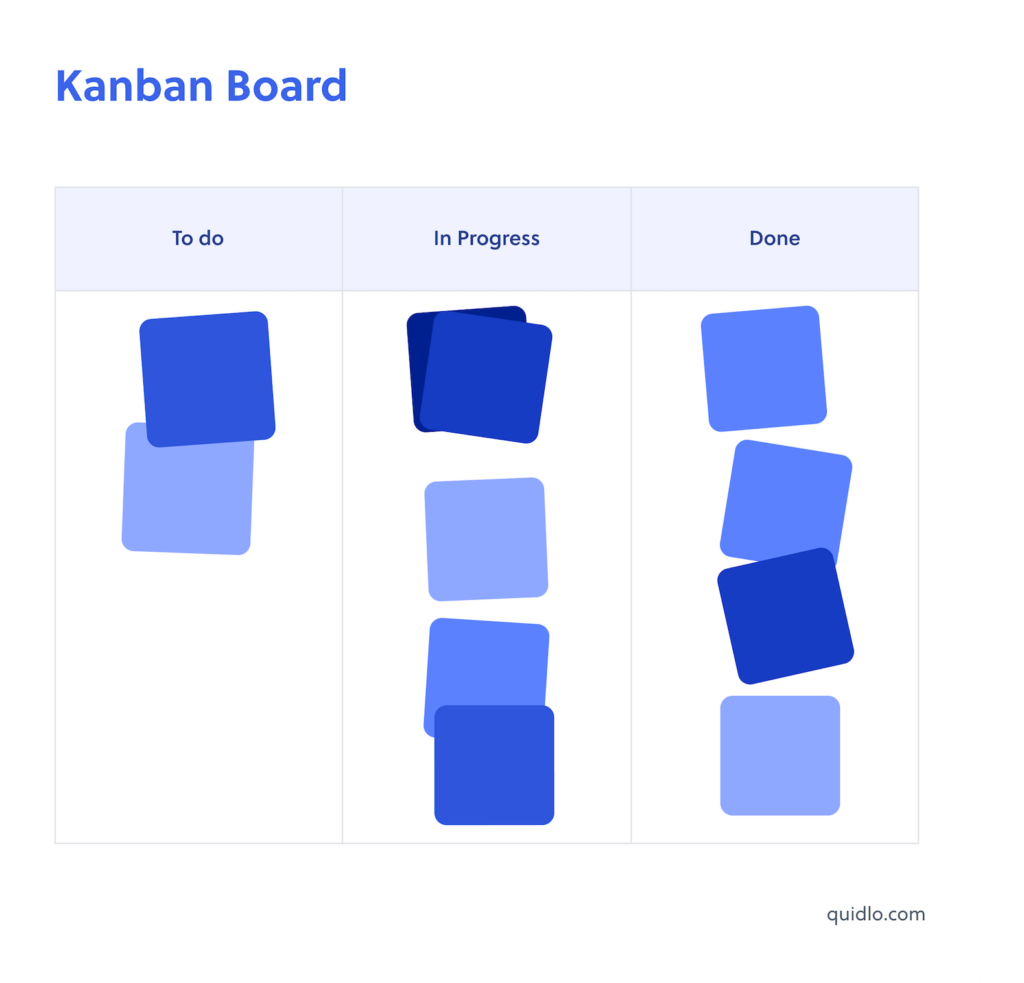
Write one task on each sticky note. Your sticky notes represent tasks that need completing. Next, stick the notes in the relevant columns, depending on the phase the tasks are in. As you make progress with your tasks, move sticky notes through the columns.
Alternatively to using a physical board, or pen and paper, you can use online tools, like Trello or Asana.
In the Kanban technique, you can customize the principles to fit your routine. You can break big projects into smaller, more manageable tasks. Tracking the progress of all the tasks will put you in control of the entire work situation.
On the other hand, Kanban doesn’t label your tasks in terms of importance or urgency. There are no time limitations, so it may not be straightforward to predict when your team will finish their tasks.
15. ABCDE method
Another from the list of popular and effective time management strategies is the ABCDE method, invented by Alan Lakein. Lakein introduced this technique in his 1973 book, “How to Get Control of Your Time and Your Life.”
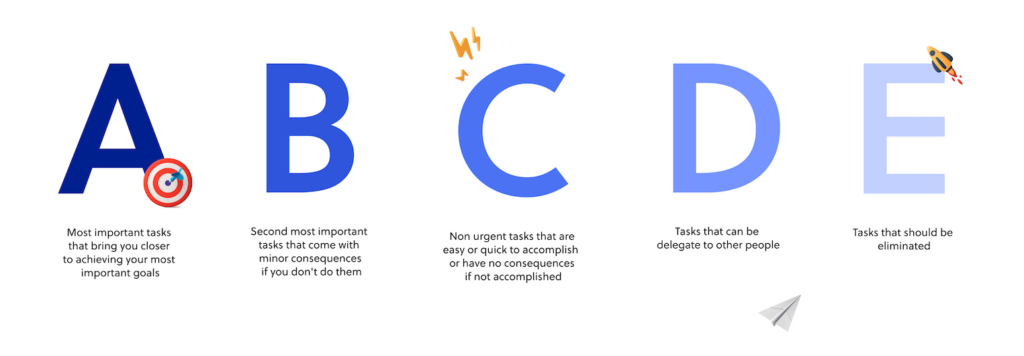
The ABCDE method provides a guideline for prioritizing your tasks and optimizing the time needed to complete them before the deadline.
To follow this technique, you need to create a to-do list and categorize each new task that comes your way, assigning it into one of the following categories:
A – as the most important task
B – less important tasks
C – tasks that, if not done, won’t have any consequences
D – tasks that you can delegate
E – tasks to eliminate
The idea is to start with the tasks from the A and B categories before getting into activities from other groups.
The ABCDE method will help you to recognize what tasks you can delegate to others or remove from your to-do list.
One downside of this method is that it doesn’t label tasks by urgency. Thus, you might miss out on the jobs that need your immediate attention.
16. 1-3-5 Rule
The 1-3-5 Rule is a simple strategy that brings structure to the way you do things and helps you manage tasks. It’s based on a three-step formula. Each day, you focus on doing 1 Big Thing, 3 Medium Things, and 5 Little Things.
Once you complete your big job, you’ll have the motivation to work on the rest of the tasks. Signing off your medium tasks will allow you to move forward with your larger projects. The small jobs are usually nice and easy to complete, so they’ll inspire you to move forward.
The 1-3-5 method helps to organize your work and get through your to-do list. It’s flexible, so you can change the number of tasks to suit your workload.
As a disadvantage, deciding how much time you’ll dedicate to each task is not straightforward. So, if you devote too much time working on your one big thing, you may run out of time for your medium and little things.
17. The Inbox-Zero
The Inbox-Zero method is one of the most popular time management strategies for email management. It’s a straightforward approach to managing your inbox. The main rule is to keep your email inbox empty or as close to it as you can.
The Inbox-Zero approach was developed by Merlin Mann, called the “Inbox Zero guy.” Merlin is a writer, podcaster, and expert in the field of productivity.
The technique helps to avoid distractions and focus on monotasking. Through Effective planning, you manage your time and stress better.
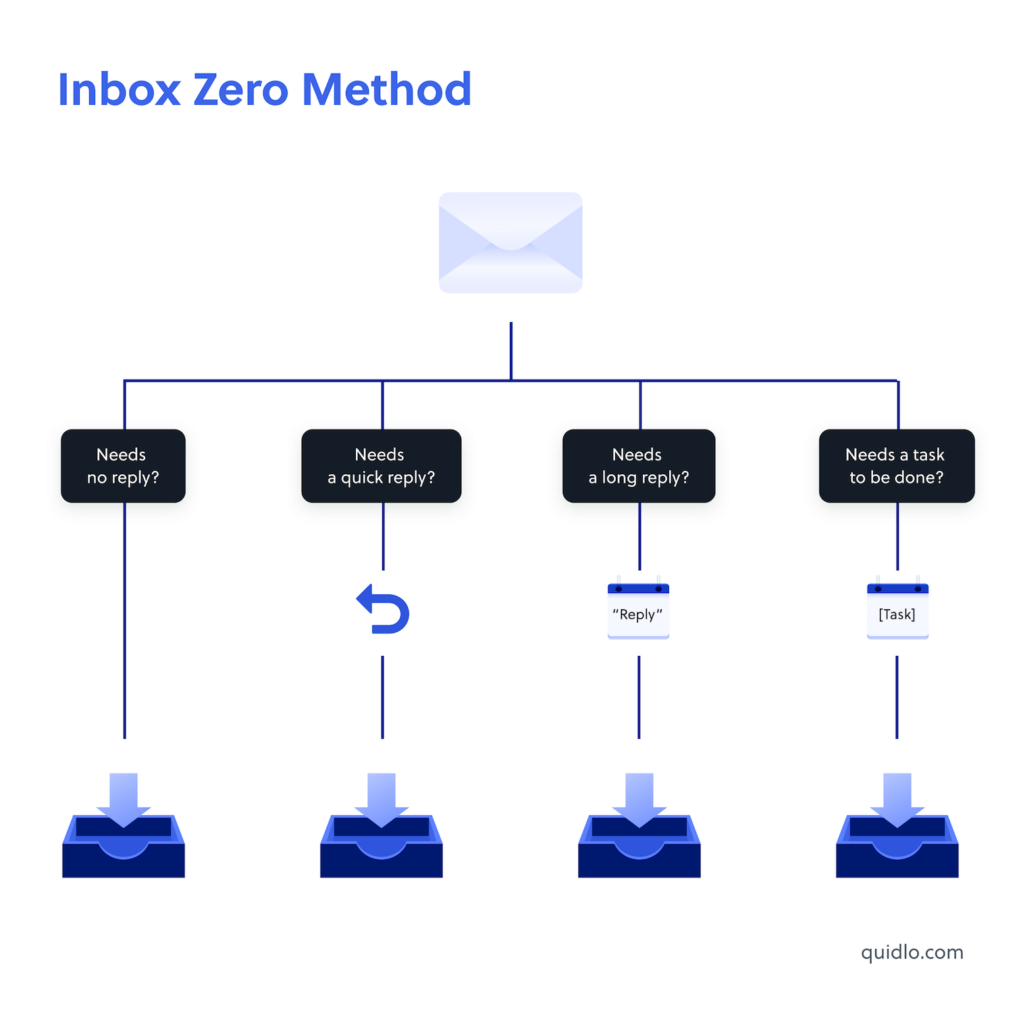
To get to the inbox zero stage, you have to determine the time of day you’ll work solely on managing your inbox. You should prioritize your emails as follows:
Respond right away to your most important messages, plus emails you can answer quickly
Move any emails that’ll take longer to respond to a designated folder. You can give it a name that needs a response. Then allocate some of your inbox time to answering those emails.
Forward any messages that you can delegate—for example, ones where your team members can reply to on your behalf.
Delete/Archive unneeded or old messages
Focusing on inbox management only within a specific period of the day means you won’t get distracted while doing your other critical tasks.
As Inbox-Zero only deals with inbox-related tasks, it’s best if it’s combined with other time management techniques.
How To Choose The Best Time Management Technique?
You’re now familiar with some of the best time management techniques to try in 2025. You can choose your favorite technique and use it to achieve a better work-life balance.
Keep in mind that different techniques are excellent at achieving specific goals. For example, if you want to learn how to prioritize best, try the Eat The Frog or the Eisenhower Matrix technique.
If your main goal is to improve your time management skills and increase productivity, you can try the Timeboxing or the Pomodoro technique. Finally, if you’re unsure how to focus on your urgent and important tasks in your most productive hours, try the Deep Work or the Flowtime technique. Therefore, you can choose one or try different time management techniques based on your needs.
However, whichever technique you pick, it’s crucial to stay disciplined and consistent. You’ll soon know how to make good judgments on valuing your tasks and working more efficiently to save time for activities that matter most.
Tracking and analyzing your improvements will help you to understand how you work and use your time. With the right time management tools, like Quidlo’s Timesheets, you can adapt most of the time management techniques to your busy schedule.
Now it’s your turn to incorporate these time management tips into your workflow. And, if one technique doesn’t work for you, try a different one. There’s plenty to choose from!



